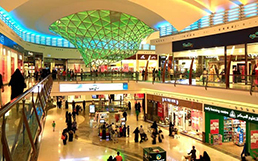Correlates of Consumer Patronage of Shopping Mall in Metropolitan Lagos

Abstract:
The
research is aimed at investigating the pattern and extent of relationship among
factors that stimulate consumer patronage of shopping malls in metropolitan Lagos.
The Study utilizes survey method with questionnaire and interview as the two instruments
used in data collection. Analysis is done largely using descriptive statistics.
Also a four point Likert scale is used to measure the variables which form the basis
for the use of regression model as the sole tool used in hypothesis testing. Based
on the survey of urban shoppers, the study analyses the cognitive attributes of
the shoppers towards attractiveness of shopping malls and intensity of the shoppers.
The results of the study revealed that ambience of shopping malls, assortment of
stores; sales promotions and comparative economic gains in the malls attract higher
customer traffic to the malls. The analysis also revealed that class difference
of consumers play an important role in choosing shopping malls. In other words,
the research reveals a significant relationship between shopping malls sales growth
and middle and upper class patronage. The study recommends that Mall Managers should
therefore develop appropriate tenancy policies for retaining firms in reference
to the socio-demographic factors of customers to satisfy different segments. An
appropriate mix of anchor tenants who have different target groups would better
attract customers to shopping malls and such assortment of stores could co-exist
in a shopping mall successfully without conflict of interest. Shopping mall managers
should focus attention on providing information about retailer’s offers beforehand
for the customers to make their purchase decision prior to mall visit. There is
the need for shopping mall managements to increase social and recreational facilities
which acts as driving factors in augmenting the customer’s traffic to the shopping
malls. Also, there is the need for government to monitor the sitting of shopping
malls in order to ensure adequate space and avoid congestion which is the major
feature of traditional markets.
Keywords:
Correlate, Consumer, Patronage, Shopping, Mall, Product.
References:
[1]. Acto,
F. and F. D. Anderson (1979), the influence of learning on store Image and Differentiation:
An Empirical Demonstration, in N. Beckwith et al. Educational proceedings. Chicago.
[2]. Abraham,
S. (2005) “stretching strategic thinking “Strategy
& Leadership Volume 33 Number 5 pp.5-12.
[3]. Belk,
Russel W., (1975), Situational Variables and consumer.
[4]. Behavior.
Journal of Consumer Research, 2 (December)
157-164.
[5]. Donovan.
[6]. Bitar,
J. and Hafsi, T. (2007), strategizing through the Capability Lens: Sources and Outcomes
of integration. Management Decision Volume
45 3 pp. 403-419.
[7]. Cravens,
D. (2006) Strategic marketing’s Global Challenges and Opportunities. Handbook of Business Strategy Volume 7 number
1 pp. 63-70.
[8]. Darling,
J. R. (2001) “Successful Competitive Positioning: the Key for entry into the European
consumer Market”. European Business Review,
Volume 13 Number 4. Pp.209-221.
[9]. Doyle,
P. (1995), “Marketing in the new Millennium”. European Journal of Marketing, Vol. 29 No.3 pp. 23-41.
[10]. El-Ansari,
A. I. (2006) “Marketing Strategy: Taxonomy and frameworks” European Business Review Volume 18, Number 4 pp.266-293.
[11]. Gardener,
M.P. (1985), Mood states and consumer behavior: A critical Review. Journal of consumer Research, 12 (December),
281-300.
[12]. Groeppe-Klein,
A. (1997), The influence of the Dominance Perceived at the point of sale on the
price-Assessment, @ European Advances in Consumer
Research, Vol. 3, eds. English, Basi G. Und Anna.
[13]. Ibrahim,
M. F., and Galven, T.W.R. (2007). New age retail tenants: A new phenomenon Journal of retail and Leisure property, 7(3),
204-215.
[14]. Leo, P.
Y. and Philippe, J. (2002), Retail centers: Location and consumer’s satisfaction.
The service Industries Journal, 22 (1) 122-146.
[15]. Maronick,
T. J. (2007) cially retail center’s impact on downtown shopping, dining, and entertainment.
Journal of Retail & Distribution, 35 (7),
556-568.
[16]. Miranda,
M. Konya, L. and Havira, I. (2005) Shopper’s satisfaction levels are not only the
key to store loyalty. Marketing Intelligence
and Planning, 23 (2) 220-232
[17]. Morschett,
D., Swoboda, B and Foscht, T. (2005), perception of store attributes and overall
attitude towards grocery retailers: The role of shopping motives. International Review of Retail, Distribution
and consumer Research 15 (4), 423-447.
[18]. Nevis,
J.R. and Houston; M. J. (1980), Image as a component of Attraction to Intra-urban
Shopping Areas. Journal of retaining, Vol.
56 (spring), 77-93.
[19]. Pearce,
M. R. (1992. Retail Marketing Management: Text and cases. Scarborough Nelson Canada.
[20]. Peterson,
Robert A. and Maria C. Merino (2003), A Consumer Information Search Behavior and
the Internet. Psychology & Marketing,
20 (2), 99-1.
[21]. Parsons,
A. G. and Ballantine, P. W. (2004), Market dominance, promotions, and Shopping Mall
group performance. International Journal of
Retail & Distribution Management, 32 (10), 458-463.
[22]. Rajagopal,
A. (2006), Stimulating retail sales and upholding customer value. Journal of Retail and Leisure property, 6(2),
117-135.
[23]. Wakefield,
K. L. and Baker, J. (1998), Excitement at the mall: Determinant and effects on shopping
response. Journal of Retailing 74 (4), 515-539.
[24]. Zenithal,
A., Parasuraman, A. & Berry, L. L. (1990). Delivering Quality Service, New York:
The Free Press.

